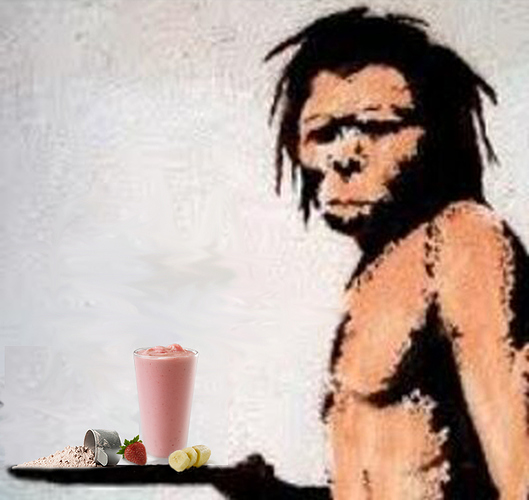What the
Cool. That’s why you’re here, right?  Take a look at some of the studies and let me know what you think.
Take a look at some of the studies and let me know what you think.
The chart you linked to shows the grams of resistant starch within those foods. Many whole foods have - along with a lot of insulin-spiking carbs - also resistant starches that feed our gut bacteria. (I’m not sure why you posted the chart - to ask about that?) But for folks whose gut biome needs boosting and who are very sensitive to carbs, it can be helpful to have the starches themselves without the carbs, thus the kinds of supplemental powders at the top of the thread.
I find this an interesting area but I’m not particularly advocating the use of supplemental resistant starches. Many folks suggest that our gut bacteria adjusts to the (generally) lower fiber of keto and can be equally healthy; it’s just a different profile of bugs.
Thats the look I had on my face this morning when I blended my butter/coconut oil coffee, HOT.
Air expands a lot from room temp of about 70 degrees to roughly 200 degrees when the blender kicks in and dumps tons of coffee heat into the small amount of air in the container. Coffee go BOOM! Big bada boom. The seal blew out and I got about 3 ounces of very hot coffee all over the place.
So in a potato, our example, are there two types of starches ?
Regular potato starch and
Resistant potato starch ?
This list has potatoes at 64% insulinogenic with an insulin load (g/100g) at 26. Those are pretty high.
Would you rather eat 900g of blackberries or 100g of potatoes ? Same insulin load.
Yes, pretty much. Some foods are high in resistant starch when they’re raw or unripe. Raw potato, green banana = good sources of resistant starch; cooked potato = terrible (as you indicated); cooked and cooled = decent source of resistant starch but I would imagine you’re still getting some insulin response.
In any case, no one here is suggesting eating potatoes. From Dr Eenfeldt:
The beauty of resistant starch is that it doesn’t break down to glucose. It isn’t broken down at all in the body, but instead it becomes food for the gut microbiome in the colon. The gut bacteria digest the resistant starch into short-chain fatty acids, which are absorbed by the body.
Therefore, resistant starch will not act as a carbohydrate. Instead, it is food for gut bacteria and what your body absorbs has been converted into fat.
Resistant starch is in reality LCHF – low carb, high fat – with food for the gut flora as a bonus.
Feeding the good gut bacteria – and the cells of the intestinal lining – seems to be able to affect hormone levels in the body (GLP-1 etc.), that in turn has an effect on blood sugar regulation and insulin sensitivity.
It seems also to be beneficial to ensure that gut bacteria and cells get adequate nutrition. Our ancestors no doubt did so, as there are plenty of sources of resistant starch in nature.
That’s from this article if you’re curious.
He goes on:
The easiest way to eat a lot of resistant starch – free from regular starch – turns out to be cold potato starch. Not very yummy, but a couple of tablespoons stirred in water, per day, seems to be enough for a positive impact.
It may be wise to start with less and increase gradually to reduce the risk of a side effect: gas. Also note that you shouldn’t heat the potato starch – then it will be converted to regular starch that raises your blood sugar.
Those who are not carbohydrate sensitive – for example lean, healthy, exercising people – have more possibilities:
Resistant starch – along with plenty of regular starch – are found for example in beans, lentils and peas.
A lesser portion of the starch in a boiled potato or boiled rice is converted to resistant starch if it’s allowed to cool before being eaten.
Raw potatoes or green, unripe bananas are also possibilities.
Another article with more detailed science (and you’ll probably understand it better than I do!) is here. There’s a long list of studies cited in that one, and improving insulin resistance seems to be a recurring theme.
Robert, that is interesting; I’d never thought of that happening. Yes - right about 25% expansion, with only one way to get out…
Yes, would be true if resistant starch were just less of something else.
resistant starch =/= starch in how the body processes it and one of the main LC drs calls it not just LC but LCHF
But - whatever, I don’t even take RS myself; I was just answering the original poster’s question, and thought it might be an intestesting discussion. @VLC.MD if you find out what RS is, I’d be curious to hear your take on it (because it functions like soluble fiber but I don’t think you can use the terms interchangeably). It’s not a marketing term - or at least it wasn’t until it got lots of press a few years ago - and it has a strong ancestral basis.
Once of the things Cordain pointed out on the old Paleodiet Group of more than a decade ago was the use of root veggies being fairly Paleo, due to their lower glycemic response. This does not include potatoes, as they are considered tubers rather than veggies. Root veggies such as carrots, turnips, rutabagas, parsnips, etc. I’ve used beef stew with root veggies for recompensation quite often in the past.
One of the takeaways I have here is RS can be very beneficial, doesn’t raise BG levels. With a very big BUT behind it. DONT HEAT IT UP. I haven’t found anything specific as to how hot it can get, but cooking it turns it into plain old carbohydrate. What would be nice, and a miracle, is to find out how to take said raw potato, and make french fries with it, while not killing the RS. Wow. I could make millions.
French fries are my Kyptonite. The very day I was Dx with T2D I had just come from 5 Guys. Where I had a small hamburger and a LARGE side of cajun fries. Large being a misnomer. 5 Guys large fries is probably equal to three large potatoes. Basically its a brown lunch bag full of seasoned fries.
Welcome to the grand opening of “KETO BOBS”. Bacon-burgers with coconut flour bread and RS fries.
Free refills on your butter coffee in the morning.
Richard Nikoley has a whole recipe with cooked, cooled potatoes that then he reheats but not enough to break down the RS. BUT he’s relatively high carb in his general approach,I think, and I bet there’s a whole lot of just plain old starch in those along with the remaining resistant starch…
Just don’t have more than 20 g and you’re good! 

Remember the commercial? You cant have just one.
EDIT:
https://g.co/kgs/RtA7Yj
For some reason I couldn’t just copy the nutrition label.
But 181 carbs. a little over 9 times too much. [sigh]
and compare "little’ fries.
https://g.co/kgs/4nPsbU
Still [sigh]
 Robert, no doubt. Nearest Five Guys to me gives you a lot of fries, then dumps another pound or two of them in the bag, on top of everything else…
Robert, no doubt. Nearest Five Guys to me gives you a lot of fries, then dumps another pound or two of them in the bag, on top of everything else…
Yeah, I forgot about having to dig my way to the little ball of foil buried under a mountain of FF. !7X^D


